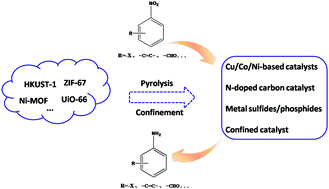Metal–organic framework (MOF)-derived catalysts for chemoselective hydrogenation of nitroarenes
Abstract
Chemoselective hydrogenation of substituted nitroarenes to the corresponding anilines is one of the most important reactions in fine chemistry, since functionalized anilines are industrially important and valuable intermediates for a variety of agrochemicals, pharmaceuticals, dyes, and pigments. However, when one or more reducible groups (e.g., C![[double bond, length as m-dash]](https://www.rsc.org/images/entities/char_e001.gif) C, C
C, C![[triple bond, length as m-dash]](https://www.rsc.org/images/entities/char_e002.gif) C, C
C, C![[double bond, length as m-dash]](https://www.rsc.org/images/entities/char_e001.gif) O, C
O, C![[triple bond, length as m-dash]](https://www.rsc.org/images/entities/char_e002.gif) N, etc.) are present in a nitroarene molecule, the chemoselective hydrogenation of the nitro group is still a great challenge. MOF materials are receiving widespread attention in the catalytic field attributed to their rich elements, high specific surface area, adjustable pore size and so on, and can be used as precursor materials for catalyst design. This review introduces the research progress of MOF-derived catalysts in the selective hydrogenation of nitroarenes, including (1) pyrolysis catalysts based on MOF materials, such as Cu, Co and Ni based catalysts, N-doped carbon materials, transition-metal phosphides and sulfides, and (2) confined metal nanoparticle catalysts. As for different MOF-derived catalysts, the structure–activity relationship and the key factors affecting the catalytic performance were analyzed.
N, etc.) are present in a nitroarene molecule, the chemoselective hydrogenation of the nitro group is still a great challenge. MOF materials are receiving widespread attention in the catalytic field attributed to their rich elements, high specific surface area, adjustable pore size and so on, and can be used as precursor materials for catalyst design. This review introduces the research progress of MOF-derived catalysts in the selective hydrogenation of nitroarenes, including (1) pyrolysis catalysts based on MOF materials, such as Cu, Co and Ni based catalysts, N-doped carbon materials, transition-metal phosphides and sulfides, and (2) confined metal nanoparticle catalysts. As for different MOF-derived catalysts, the structure–activity relationship and the key factors affecting the catalytic performance were analyzed.

- This article is part of the themed collection: 2021 Focus and Perspective articles


 Please wait while we load your content...
Please wait while we load your content...